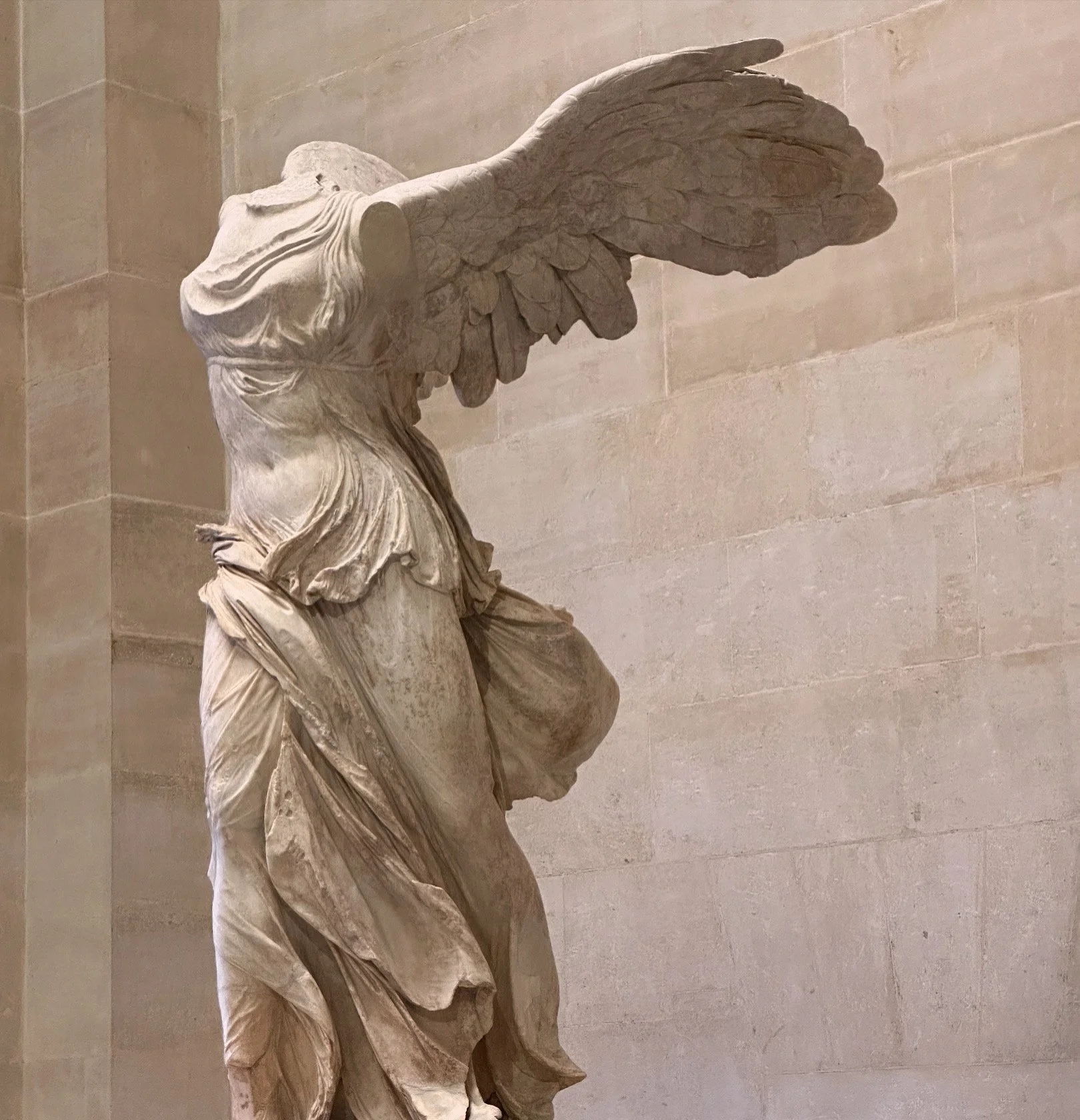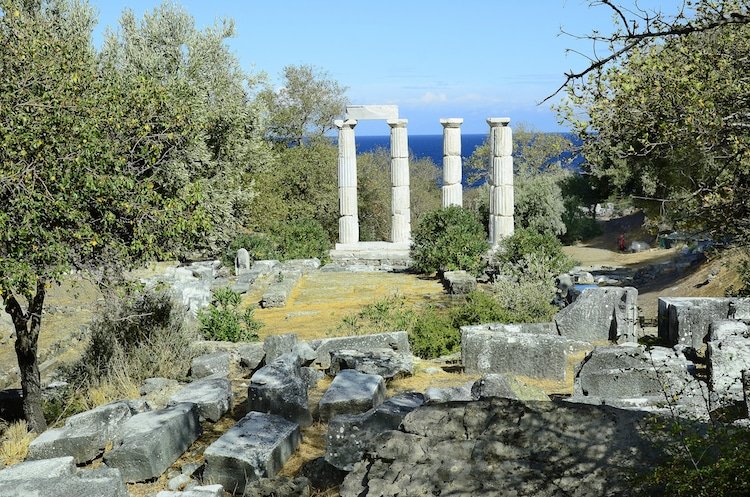Winged Victory of Samothrace, is the majestic headless lady that stands high above the Daru staircase looking like she is about to take flight. It was 160 years ago this week on May 11, 1864, she finally arrived at the Musée du Louvre.
Vice Council to Andrinople in the Ottoman Empire (Turkey today) Charles Champoiseau heard that the island Samothrace was filled with antiquities. Charles knew that Napoleon III was very interested in any and all antiquities for the French National Museum. The French Ministry of Public Instruction approved a 2000 f (close to 10k today) On March 6, 1863, the expedition began on the island in the Aegean Sea. On April 15, 1863, diggers unearthed a grand portico and found the right section of a female bust. As soon as Champoiseau saw it he instructed them all to keep digging in the area. Draped fabric, feathers, and the lower body of the statue was soon discovered, 118 pieces in total.
Dating to the Hellenisitc period that ran between 323 to 32 BC, she was created in the first quarter of the 2nd century BC between 200 - 175 BC, Champoiseau was in awe of what they had found. “Sheer marble muslin pressed by the wind against the living flesh,” Champoiseau wrote in his journal and was struck by how amazing the quality of the fragments. At the same time, large gray stones were found but left behind believing they were part of another funerary monument, we will address those in a bit.
In May 1863 after wading through the international arguing, she finally left for Paris for a voyage that would take almost a year. From Samothrace, she traveled on the French ambassador’s ship to Constantinople and eventually to Toulon where she sat for six months while the government argued about who should pay for her final journey to Paris.
On May 11, 1864, the 2nd century BC statue was over 118 pieces and was handed to the Louvre curator of Antiquities, Adrién de Longpérier for the first recreation and restoration. Adrién believed the largest piece of her should be displayed immediately for the public. The largest piece was the right side of her lower body with the smooth draping of her tunic. Enrico Penelli had just restored the vases of the Campana collection and was asked to tackle the 118 pieces of the yet-to-be-known statue.
Prior to 1850, restoration projects at times resulted in a reimagination of statuary. Many Greek and Roman statues were updated and changed at the hands of curators. A few pieces in the Louvre have changed from Athena to Psyché with a simple change of a head or attributes. Since 1850, statues have only been restored from pieces they have found and for the integrity of the statue.
While Penelli tackled the puzzle that was the marble pieces and how to handle the large parts that were missing. In 1866, Adrién de Longpérier placed the largest piece in the Salle des Caryatids and then to the Salle des Tibre amongst the Roman statues which is where Venus de Milo now lives.
In 1873 German scholar Alexandre Conze led an Austrian architectural team to the island to study the remaining structures of Samothrace. Two years later a report was published and inspired architect Alois Hauser to look further into the blocks left behind. Once placed together they created the prow of an ancient battleship.
Hauser had seen a Tetradrachm coin minted in between 301 and 292 BC under the reign of Demetrios Poliorketes. The coin shows a Winged Victory on top of a ship. In her right hand, she holds a long trumpet that she is blowing, and in her left hand a long stylis that was taken from an enemy ship. WInged Victory, or Nike in Greek history was the daughter of Titan Pallas and Oceanide Styx.
A chance encounter with Champoiseau and Conze in the Spring of 1879 on a ship found the two dishing over their journals and notes on Victory. In July Champoiseau returned to Samothrace and had all the large stones left behind packed and sent to Paris. This time it only took four months. In December 1879, the first reconstruction of the ship and base came together in the Cour de Sphinx.
The second and biggest restoration came in 1880 under Felix Ravaisson-Mollien. The former transcriber of the manuscripts of Leonardo da Vinci was named curator of Roman and Greek antiquities in 1886 and spent endless hours researching Victory. Felix discovered that plaster was easier to replicate and reproduce missing pieces of the wings and body rather than a heavier marble. Under his curatorship he had the entire right wing recreated, removed a part of her left arm that was not based on actual pieces and attached pieces of the waist of her tunic.
Unlike statues of the Renaissance, Victory was created in pieces, not from one large stone. Using Paros marble from the nearby island, the white marble is one of the finest there is. The base and ship is Lartos marble in Rhodes, the gray-grained marble stands out against the white of the statue.
Retaining the original marble for the new pieces was impossible. Felix used plaster, Carera marble, and marble powder used for joints in the right wing, left breast shoulder, and upper waist. After three and a half years the restoration was complete and where to put her was the next big question. Briefly, they thought about putting her in the garden of the Carrousel but thankfully that was turned down a unanimous decision was reached placing her at the top of the Daru staircase of the Denon wing.
The Escalier Daru just might be the 2nd most famous thing in the Louvre as it leads up to the stunning Winged Victory. Originally the Escalier du Salon led from the entrance of the Rotonde de Mars to the Salon Carré. Under Napoleon III the entrance moved to the Pavillon Denon and two new staircases were created on either end.
Named for Pierre Daru who began his military career at the end of the Revolution and worked his way up to the Minister of War. So loyal to Napoleon that he named his first son after him. He not only has one room in the Louvre he has three!
Hector Lefuel wanted to honor the former staircase of Percier & Fontaine but was shot down. The 2nd empire of Napoleon III would end and Lefuel died before the Escalier Daru was finished. In 1882 Edmon Guillaume picked Jules-Eugene Lenepveu to create a set of Victories in mosaics that were added in 1887 to honor its new grand resident, Winged Victory.
Victory of Samothrace was placed in 1883 in a setting that some called a concert hall. It was quite busy and filled with antiquities on the walls and landings of the staircase. Guillaume painted the walls of Pompein red like the two large format French painting rooms and added blossoms around the scrolling foliage. “A summary of the riches of the Louvre” was the theme for the two decorated domes topped with windows.
Artist Jules-Eugene Lenepveu created each of the allegories and executed them by students of the National Mosaic School of Paris. In the elliptical dome above Victory, dedicated to Antiquity are allegories symbolized Egypt, Assyria, Greece, and Rome. Above that in a ring are medallions of artists Cheops, Gouda, Phidas, and Vitruvius.
The second dome above the staircase itself was dedicated to the Renaissance with allegories of France, Germany, Italy, and Flanders and medallions with portraits of Raphael, Poussin, Durer, and Rubens.
Two smaller domes for Holland and England over the staircase and the two smaller ones opposite the landing to the French rooms were dedicated to the 16th & 17th centuries. The other double arches evoked the Middle Ages, modern times, Orient, Spain, Flanders and Germany. The domes were revealed in August 1897 but would only last 37 years.
In 1932 director Henri Verne began the modernization of the Louvre and that beautiful ceiling that was often criticized for being too dark was covered with wallpaper that replicates the stone of the walls. They are still safely hidden behind and as early as 2010 there was talk of uncovering them. The 1932 renovation also opened the landing by pushing the small steps back giving Victory the grand space she deserved.
The 3rd restoration of 1932-34 by Etienne Michon pushed her further against the wall. The original placement of her statue in Samothrace was at a ¾ view with her left side facing out. That wasn’t an option for the Escalier Daru and would change the perspective numerous directors wanted.
In August 1939 when the rest of the Louvre was being packed and moved to the Loire, Victory was not safe at the top of the Escalier Daru under a glass window in case a German bomb was to hit. On September 2, 1939 as the war officially began workers wrapped her in a tarp and ropes and built a wooden cage around her. As people watched she was lifted off her bow and placed at the top of the steps and then slowly lowered down the 53 marble steps.
Victory would remain in the Louvre until the end of October when the Germans were closer and closer toParis. She was one of the last to leave the Louvre heading to the Chateau de Valençay in the Loire with Venus de Milo and Michelangelo’s Slaves and spent six years in the Loire valley. On. June 21, 1945, when she climbed the stairs a final time to return to her perch as the first thing to return to the Louvre.
In 2013 an intense scientific study of the statue was undertaken. All the pieces were separated and many of the original 2nd century BC pins and dowels were replaced. The entire mission of a restorer is to take the entire history of a piece and respect all of the past work undertaken but to only make changes that can later be reversible. In this day and age the technology on hand can see every change and the original intent of the artist and all comes into play.
In the most recent renovation, they found Persian blue paint on the statue that could only be seen through an x-ray. Undertaken in the nearby Salle des Sept Cheminée what was once the bedroom to the king and steps from the Daru staircase.
The restoration took 8 months and when she returned she was placed on a new Carerra marble base raising her off the landing as people used to stand on it. Today they are constantly touching it until a guard or myself yells at them.









